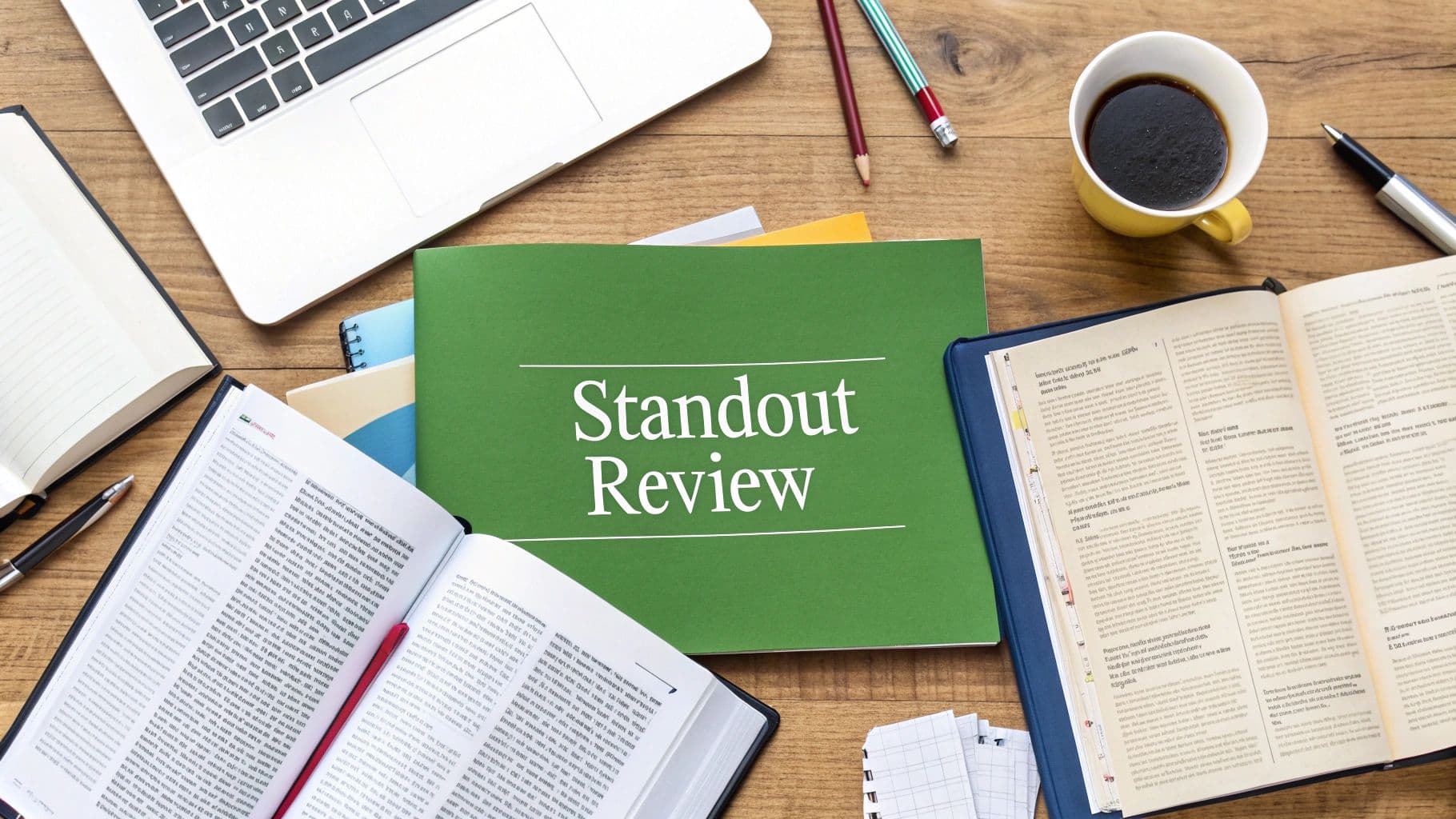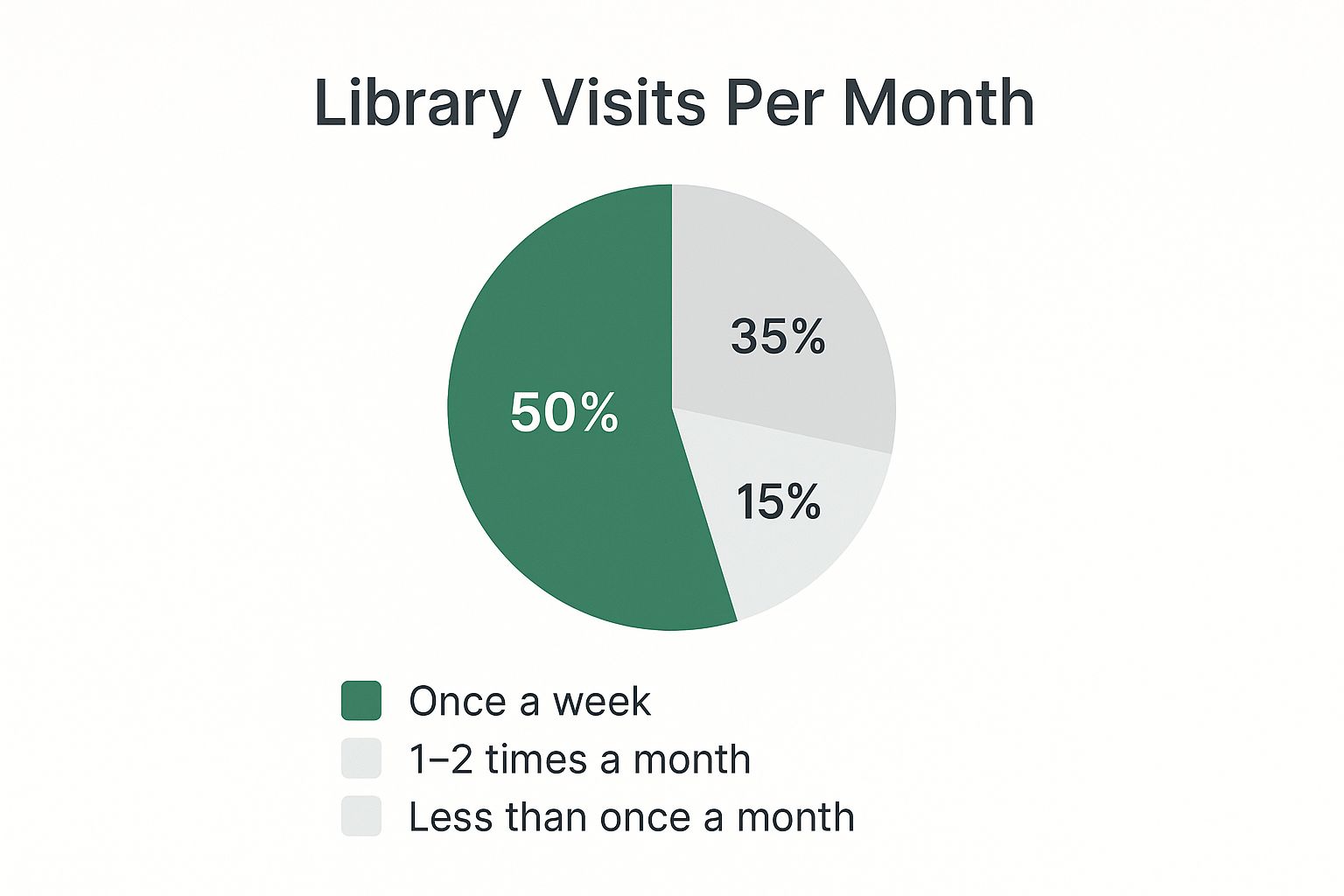
How to Write a Literature Review That Gets Noticed
August 9, 2025
Alright, let's ditch the academic jargon and get real about what a literature review actually is. It's so much more than just a fancy, glorified book report.
If you’ve ever felt like writing one is a tedious chore you have to get through before the real research begins, you’re missing out on its true power. It’s not just a checklist of who said what.
Think of it as your first real contribution to the scholarly conversation. This is the scaffolding that holds up your entire project, whether it’s a term paper or a full-blown dissertation. A shaky literature review leads to a shaky argument, and nobody wants that.
What Is a Literature Review and Why Does It Matter?
Let's clear something up right away: a literature review is a critical, structured conversation with the research that already exists in your field. It’s your chance to show you’ve done your homework and you know what you're talking about.
A well-crafted review is what gives your own research context and a reason to exist. It’s not just a formality; it’s the foundation.
The True Purpose of a Literature Review
So, what’s the point? A literature review accomplishes a few crucial things that set you up for success:
- It Proves You Belong: It shows your professor, your supervisor, and your peers that you have a solid grasp of the topic. You know the key players, the big debates, and the foundational theories that everyone else is building on.
- It Finds the "So What?": A great review maps out what we already know. In doing so, it shines a giant spotlight on what we don't know. This is the famous "gap" in the research—and it's exactly where your work comes in.
- It Carves Out Your Space: It helps you strategically position your work. You aren't just shouting into the void; you're showing exactly how your research extends, challenges, or refines what came before. You’re joining the conversation with a clear purpose.
A great literature review does more than summarize; it synthesizes. It pulls together different threads of research to create a new, clearer picture. You start to see patterns, trends, and contradictions that you'd miss by looking at each study on its own.
Going Beyond a Simple Summary
This is where the real magic happens. Moving from just summarizing to synthesizing is the goal.
A summary just reports what someone else said. "Smith (2020) found X." Okay, great. But synthesis? That's when you start connecting the dots.
For instance, you might write that while Smith's (2020) findings seem to support a popular theory, they directly contradict what Jones (2018) discovered in a qualitative study. Suddenly, you have a new question: maybe this phenomenon works differently in urban versus rural areas? Now that's interesting.
This is what transforms a literature review from a procedural hurdle into a powerful analytical tool. It makes you an active participant in your field, not just a passive reader.
Finding and Evaluating Your Sources
Once you have your research question nailed down, the real treasure hunt begins. The challenge isn't just finding information; it's finding the right information without getting buried in a sea of irrelevant papers. A smart, systematic literature search is your best defense against feeling completely overwhelmed.
This isn't about aimless Googling. It's a targeted strategy to uncover the most important and authoritative work in your field. Your journey should start in academic databases. While Google Scholar is a decent first stop, mastering platforms like JSTOR, PubMed, or Scopus is what separates a good literature review from a great one. These are built for deep, specific searches.
Mastering Your Search Strategy
To get the most out of these powerful databases, you have to think like a librarian. That means using advanced search operators to filter out the noise and zero in on what you need.
- Boolean Operators: Use
ANDto combine different ideas (like "remote work" AND "employee burnout"),ORto catch synonyms (e.g., "wellbeing" OR "mental health"), andNOTto kick out topics you don't want. - Phrase Searching: This is a simple but powerful trick. Putting your search term in quotes, like
"work-life balance", tells the database to find that exact phrase, which dramatically cleans up your results. - Wildcards and Truncation: Use symbols like an asterisk (*) to find all variations of a word root. For example,
manag*will find manage, management, and manager, saving you from running multiple searches.
This kind of systematic approach has never been more critical. A recent analysis, for instance, found that medical informatics literature grew at an average rate of 12% per year for two decades. With that much new information flooding the field, a casual search will inevitably miss key studies. A rigorous method is essential.
Vetting Sources for Quality and Relevance
Finding sources is only half the battle. The real critical thinking happens when you start evaluating them. Just because an article is peer-reviewed doesn't mean it carries the same weight as every other one. You need to learn how to spot the foundational, game-changing studies that everyone cites.
My favorite technique for this is what I call the "snowball method." I start with one or two highly relevant, recent articles that are perfect for my topic. Then, I go straight to their reference lists and start digging. This almost always uncovers the foundational sources that influenced the current work—the hidden gems you might have missed otherwise.
As you start gathering papers, get in the habit of asking these key questions:
- Is the author a recognized expert in this specific niche?
- Is the journal reputable and properly peer-reviewed?
- How many times has this study been cited by other researchers? (Google Scholar makes this incredibly easy to check.)
- Does the abstract actually speak directly to my research question?
As you dig into your pile of papers, you might want to look into modern tools to chat with PDF documents. They can be a huge time-saver, helping you pull out key arguments and data points quickly.
Of course, your own ability to write with clarity is just as important. Our comprehensive academic writing style guide is packed with practical tips to help you refine your professional voice. Combining smart searching with sharp critical evaluation is what will give your literature review a rock-solid foundation.
Structuring Your Review for Maximum Impact
You’ve done the legwork. The sources are gathered, you’ve sorted the good from the bad, and now the real art begins. This is where you shift from being a collector of information to an architect of ideas. You're no longer just listing what others have said; you're weaving individual studies into a cohesive story that shows where the research on your topic stands right now.
Honestly, this is the most critical step. It determines whether your literature review will make a real impact or just fall flat. A strong structure builds a powerful, logical argument that guides your reader through the scholarly conversation. It sets the stage perfectly for your own contribution. A weak or confusing structure? It will sink even the most brilliant research.

This image pretty much nails that initial feeling—being surrounded by the raw materials you’re about to shape into something meaningful.
Choosing Your Organizational Framework
Let's get one thing straight: there's no single "right" way to structure a literature review. The best approach depends entirely on your research question and the kinds of literature you’ve dug up. Your goal is to pick a framework that best highlights the trends, debates, and—most importantly—the gaps you want to emphasize.
There are a few tried-and-true models that most researchers use.
The best structure for your literature review really depends on your goals. Are you trying to trace the history of an idea, compare different research findings, or group together common themes? Each structure tells a slightly different story.
This table breaks down the most common approaches to help you decide.
Choosing Your Literature Review Structure
| Structure Type | When to Use It | Real-World Example |
|---|---|---|
| Thematic | This is the go-to for most reviews. Use it when you want to organize around recurring concepts, ideas, or debates that appear across different sources. It’s great for synthesis. | A review on corporate social responsibility might have sections on "Environmental Impact," "Ethical Labor Practices," and "Community Engagement," pulling from various studies for each theme. |
| Chronological | Perfect for showing how a topic has evolved over time. Use this when you need to trace the development of theories or see how a concept has changed over decades. | A review on artificial intelligence could start with early theoretical work from the 1950s, move through the expert systems of the 1980s, and end with modern deep learning. |
| Methodological | Useful when the how is as important as the what. Group studies by their research methods (e.g., qualitative vs. quantitative) to compare their findings or critique their approaches. | A psychology review might compare findings from large-scale quantitative surveys on anxiety with insights from in-depth qualitative case studies on the same topic. |
Ultimately, many of the best reviews are hybrids. For example, you might use a broadly chronological structure but organize the content within each time period thematically. You can discover more insights about these review structures to see what fits best in different fields.
Weaving Your Narrative
Once you’ve settled on a structure, the real work of synthesis begins. This is not about summarizing one paper after another in a boring, disconnected list. Instead, every single paragraph should push your argument forward by comparing, contrasting, and connecting multiple sources.
The goal is to get beyond "Smith (2020) found this..." and "Jones (2021) found that..." reporting. You need to actively interpret these findings for your reader, creating a narrative that leads them directly to the gap your own research is designed to fill.
Think of yourself as a tour guide. You're leading the reader through a landscape of existing research. You point out the major landmarks (the seminal studies), show them the areas of heated debate, and shine a light on the unexplored territories (the gaps).
Your voice should be confident and clear. Use strong topic sentences to signal what each paragraph is about and natural transition words to ensure the story flows smoothly from one point to the next. You're building a case, piece by piece, for why your research is not just interesting, but absolutely necessary.
Writing a Cohesive and Critical Narrative

Okay, you've done the hard work of finding your sources and building a solid outline. Now it's time to shift from architect to storyteller. This is where you transform all those notes and organized ideas into a compelling, critical narrative that flows.
Your goal isn't just to report what others have said. It's to build a clear argument. Every paragraph you write should be a deliberate step, guiding your reader through the scholarly conversation and, most importantly, showing them exactly why the research gap you've found matters.
Crafting an Introduction That Hooks the Reader
Your introduction is everything. It sets the stage and needs to do more than just announce your topic. Think of it like the opening scene of a movie—it has to grab your reader's attention and immediately establish what’s at stake.
Start broad, then quickly zero in on the specific debate or problem your review tackles. Be clear about the scope—what you will and won't be covering. But don't give away all your conclusions just yet. You want to create a little intrigue and make your purpose crystal clear from the get-go.
Moving From Summary to Synthesis in the Body
This is where great literature reviews separate themselves from the rest. The body of your review can't be a boring, disconnected list of summaries. "Smith (2020) found this..." followed by "Jones (2021) found that..." is a classic mistake. That's just describing; it's not analyzing.
Instead, organize your paragraphs around ideas, not authors. Each paragraph should tackle a single theme, pulling in insights from multiple sources to discuss it. Your topic sentence introduces the theme, and the rest of the paragraph should be dedicated to comparing, contrasting, and critiquing how different studies have handled it.
Your voice is the analytical thread connecting all these different studies. You're not just a reporter; you are the guide and the interpreter. Your job is to put these sources into a conversation, pointing out where they agree, where there's tension, and where they flat-out contradict each other. This is how you build your case.
For instance, you could write something like: "While several studies point to economic factors as the primary driver of X, a growing body of qualitative research suggests that cultural norms play an equally critical, though often overlooked, role." See how that immediately creates a dialogue between sources and establishes your own analytical stance?
Finding and Maintaining Your Academic Voice
As you start synthesizing information, your own academic voice will begin to emerge. This isn't about injecting random personal opinions. It's about making your critical judgment obvious to the reader through your phrasing and structure.
Use transitional phrases to signal what you're doing:
- To show contrast: "Conversely," "On the other hand," "However"
- To build on an idea: "Furthermore," "Similarly," "Building on this"
- To point out a gap: "What remains unclear is..." "Few studies, however, have addressed..."
This kind of deep, analytical writing requires some serious brainpower. It’s tough work. To build a powerful narrative, you need to be able to concentrate, so exploring strategies to maintain focus can make a huge difference in the quality of your synthesis.
Writing a Conclusion That Points Forward
Finally, your conclusion needs to wrap everything up and drive your main point home. A strong conclusion does two things really well:
- Summarize the Synthesis: Quickly recap the major themes, the key debates, and the overall state of the research. What are the most important takeaways for your reader?
- Highlight the Gap: This is your final, most powerful move. Explicitly state the gap, weakness, or unanswered question your review has uncovered. This is what justifies your own research and provides the perfect launchpad for your study.
Editing and Polishing Your Final Draft

Anyone who writes for a living will tell you that great writing is really just great rewriting. Once you’ve poured everything into that first draft, the real work begins. This is where you transform all that effort into a sharp, professional piece of scholarship.
It's about more than just catching a few typos. This is your chance to tighten your arguments, smooth out the narrative, and make sure your work isn't just finished, but genuinely compelling. A polished literature review shows you're ready to contribute something meaningful to the conversation.
A Practical Self-Editing Checklist
Let's be honest—editing your own work is tough. You're so close to it that seeing its flaws can feel impossible. But approaching it with a plan makes all the difference. The trick is to focus on one thing at a time instead of trying to fix everything at once.
Always start with the big-picture stuff before you get lost in the weeds of grammar and punctuation.
Here’s a checklist I run through with my own drafts:
- Logical Flow and Transitions: Does one idea flow naturally into the next? A great way to test this is to read only the first sentence of each paragraph. It should read like a coherent, logical summary of your argument.
- Consistent Authorial Voice: Does it sound like you all the way through? You want to be the confident expert guiding the reader, not just a narrator summarizing what other people said.
- Clarity and Jargon: Have you used academic jargon just for the sake of it? Every technical term needs to earn its place. If a simpler word works just as well, use it.
- Citation Accuracy: This one is a non-negotiable. Go through every single in-text citation and reference. Make sure they are perfect according to your required style guide (APA, MLA, etc.). Little mistakes here can seriously damage your credibility.
One of the biggest blind spots for writers is seeing their own work objectively. Stepping away for a day or two before editing can make a world of difference. When you return, you'll see your draft with fresh eyes, making it easier to spot awkward phrasing and logical gaps you missed before.
Seeking Crucial Outside Feedback
Self-editing will only get you so far. We all have blind spots. Getting a second pair of eyes on your work—from a trusted colleague, a mentor, or a university writing center advisor—is an essential final step.
An outside reader isn't tangled up in your research. They can instantly spot an argument that doesn't land or a transition that feels abrupt. Just make sure to give them your core research question so they know what you're trying to achieve.
For a deeper dive into editing strategies, this complete guide on how to edit a paper is a fantastic resource.
Common Literature Review Questions Answered
Even with a solid plan, you’re going to hit a few roadblocks. It happens to everyone. When you're deep in the weeds of research and writing, specific questions always pop up.
Think of this section as your go-to guide for those common hurdles. Getting these details right can make all the difference, so let's clear up a few things.
How Many Sources Do I Need?
Ah, the million-dollar question. The honest answer? There’s no magic number. It all comes down to the scope of your project.
For an undergraduate paper, you might find that 10-20 well-chosen sources are more than enough to make your point. If you're working on a master's thesis, that number might jump to 30-50. For a full-blown doctoral dissertation, it's not uncommon to see over 100 sources cited.
The real goal here is comprehensiveness and relevance, not just hitting an arbitrary count. Your job isn't to list every single paper ever written on the topic. It's to prove you have a firm grip on the foundational and most important work in your specific area.
Annotated Bibliography vs. Literature Review
This is a classic point of confusion, but the distinction is pretty simple once you see it.
An annotated bibliography is basically a structured list. You have your citation, and right below it, a short paragraph—the annotation—that summarizes and maybe offers a quick critique of the source. Each entry is a standalone item.
A literature review, on the other hand, is one cohesive essay. You take all those individual sources and weave them together into a single, flowing narrative. You’re not just listing who said what; you’re telling the story of the research field, building an argument that naturally leads to your own research question.
Can I Use My Own Opinion?
Yes, absolutely—but we need to be clear about what "opinion" means in academic writing. This isn't about your gut feelings or what you believe without evidence. In this context, your "opinion" is your evidence-based, critical analysis of the literature.
Your voice comes through when you:
- Evaluate the strengths and weaknesses of the studies you're reading.
- Point out where different authors contradict each other.
- Identify the gaps that nobody seems to be addressing.
It’s your unique perspective that pulls the synthesis together, but every claim you make has to be anchored in the evidence from your sources. This critical approach is also a fantastic way to learn how to avoid plagiarism, because it forces you to truly engage with the ideas instead of just restating them.
When your draft is complete, ensuring your writing sounds natural and clear is the final step. Natural Write can help you transform robotic or complex sentences into polished, human-like text, making your arguments more compelling and readable. Try our free tool to give your literature review the professional finish it deserves.


